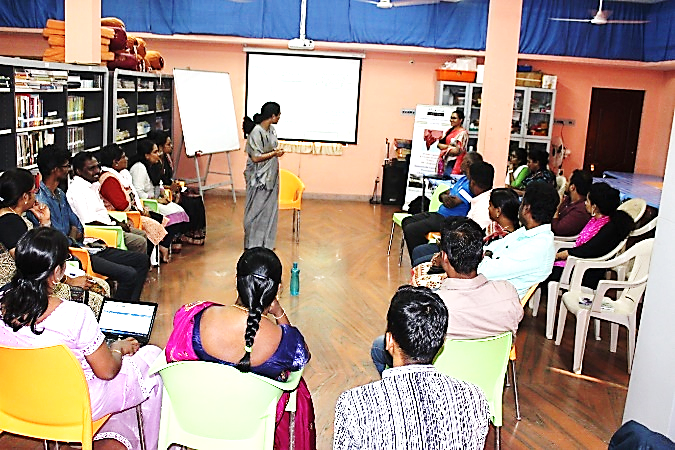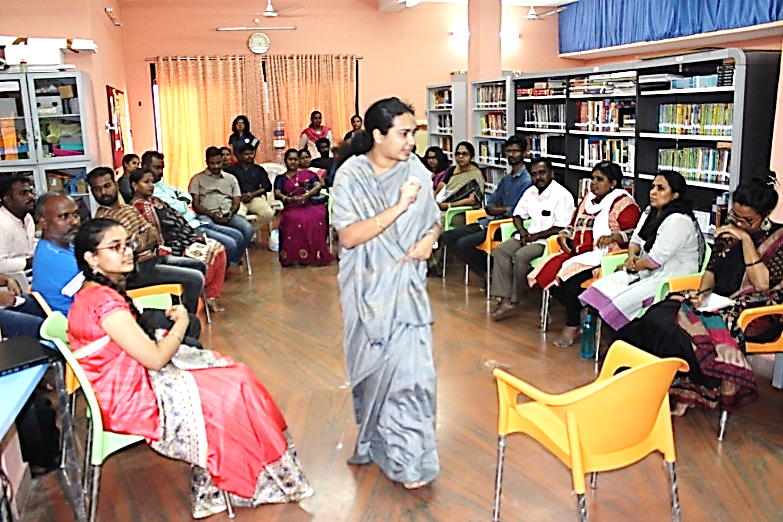Muktha Foundation, a non-profit organisation committed to the prevention of interpersonal abuse and promotion of mental health, conducted a program on awareness regarding child safety and the prevention of child sexual abuse. The mission of this foundation is to engage in training, intervention, research, and advocacy pertaining to their core areas of focus. This event was a part of their national campaign titled ‘Bhayamukth Bharath’, whereby they aim to initiate nuanced dialogue and training programmes among children and all the important stakeholders in their lives. Through this campaign, workshops on the ‘prevention of child sexual abuse’ were conducted in all the state capitals of India from 1 January to 31 March, 2019.
Child sexual abuse (CSA) is a glaring reality that poses a grave threat to the safety of our children today. ‘Prevention of child sexual abuse’ programs are often perceived to be only about ‘good touch–bad touch’ and ‘stranger danger’. However, the topic is more nuanced than most think it is. Discussion on the following topics must be conducted:
- Warning signs of CSA;
- Forms, prevalence, and myths pertaining to CSA;
- Reasons children often do not reveal they were abused;
- Tricks abusers use to gain a child’s trust (grooming);
- Signs that someone could be an abuser;
- Guidelines of response when we understand a child has been sexually abused;
- S.A.F.E.T.Y R.U.L.E.S. (a set of 11 micro ideas for children to report abuse/attempts to abuse to trusted adults).
Early Warning Signs
- Physical: Developing an aversion towards oneself or the body; unexplained bruises;
- Behavioural: Inappropriate engagement with toys; selective mutism; nightmares and sleeping problems; change of eating habits; difficulties in swallowing; regression to younger behaviour; possession of unexplained money or gifts; writing words or drawing images with sexual connotations; becoming unusual secretive and extremely withdrawn;
- Emotional: Inexplicable fear towards a particular places or person; outbursts of anger towards others, toys, and/or the self.
Breaking Myths about CSA
- Abuse is not always heterosexual.
- Women/old men can also be abusers.
- People who look and act normal can also be child molesters.
- The victim is always a girl.
- Victims always experience or express physical discomfort.
- Children lie about abuse for attention and sympathy.
Reasons Children Hesitate to Open Up
- Threats from the abuser;
- Fear of being removed from their home;
- Fear of not being believed;
- Fear of being blamed;
- Feeling ashamed due to certain other related incidents of physical punishment.
Tricks Abusers Use to Win a Child’s Trust
- Identifying parents who are casual and neglect their children;
- Being overtly nice and lenient with the child and using that to blackmail them later;
- Building trust with the family;
- Treating the child as special;
- Encouraging secrets with the child.
S.A.F.E.T.Y R.U.L.E.S: Creating Awareness About What Children Should Report
- Sexual talk: Talking in a sexually provocative manner;
- Alone caution: Asking questions such as ‘when are you alone?’ or ‘can you come and meet me alone?’
- Fear: Threatening and blackmailing by the abuser; for example, I gave you extra marks, so do not mention this to anyone;
- Electronic devices: Sending friend requests repeatedly; starting conversations in chat about uncomfortable, sexual topics;
- Touch: Focusing on three body parts only;
- Your intuition: Emphasising the feelings of a child;
- Rewards: Giving gifts or non-monetary rewards and engaging in flattery, before or after the act, for example, long drives and presents such as beauty products;
- Undress caution: Asking the child to undress or undressing in front of him/her;
- Look: Watching the child bathe or making him/her watch pornographic videos/images;
- Encouraging secrets: For example, the abuser is a relative, who tells a child, ‘I don’t like my math teacher.’ The kid also tells him, ‘I don’t like my math teacher.’ The relative records it and plays it later to threaten the child and get things done by him/her. The child succumbs to this tactic since he/she feels special that the abuser, an adult, has confided a secret to him/her.
- Seize: Seizing the child and forcefully making him/her sit on the lap.
Furthermore, the amount of time parents spend with their child has nothing to do with such incidents. A parent–child relationship should be like that of an iron fist with a velvet glove. Parents can be of many types, such as indulgent, negligent, and autocratic. Neither of these kinds help in the development of their children’s emotional, behavioural or overall well-being. It is important for teachers to inculcate this awareness in parents and help them take up a suited approach as caretakers of their children.
Moreover, there are five types of child maltreatment:
- Physical abuse;
- Neglect and negligent treatment;
- Emotional abuse;
- Commercial and other exploitation of children;
- Child sexual abuse (CSA).
Child abuse is not a single issue; it overlaps with other problems as well. The presence of one type of abuse can create risks of its other types. For instance, an abuser was interviewed about how he chose a child as his target. He disclosed that he would choose a child by observing his/her parents’ behaviour. If a parent would leave his/her child at the school without spending more time, he would choose that child as his abuse target, since that child would be more vulnerable and less likely to get help.
Traps Set by Perpetrators for the Victims of Child Abuse
- Gradual traps laid out for the child/threats by the abuser: Abusers begin with seemingly harmless activities that the child cannot recognise. For example, an abuser began by showing the child cartoons. These were regular cartoons for children, but pornographic images were flashed very briefly. It began with very short durations, i.e., for a few seconds. He gradually increased the duration to minutes. When the child realised that something seemed odd about these images, the abuser blackmailed her that he would tell people because she had been watching such videos for many days by then.
- Preferential abusers: There are two types of abusers: opportunistic (whom the child does not know very well, and they abuse the child when an opportunity arises) and preferential (they are close to the child, such as family members, teachers, etc.). The latter category of abusers is more dangerous since they are so close to the child that it is not easy to suspect them.
- Fear of being misunderstood/punished: Less than one out of 100 CSA victims speak up. This is because they may not understand what is going on, can be afraid, or might get reprimanded for bringing up such an issue. This often leads to their abuse continuing over long periods of time. Unfortunately, the victims of child abuse may also grow up to be abusers themselves.
- Abuse does not always involve physical contact: Voyeurism, sending pornographic images, sexting, viewing of the child’s genitalia without physical contact, using a child to produce child pornography are also means of CSA.
Ways to Address and Overcome These Issues
 Those dealing with students aged above 10 should be able to teach them about sexuality education, and not just sex education. It is important to know the difference.
Those dealing with students aged above 10 should be able to teach them about sexuality education, and not just sex education. It is important to know the difference.
- Usually, the use of aggressive methods such as attacking with a blade, throwing chilli powder, and/or screaming does not help children avert CSA attempts. Instead, we may ask students to practice by literally saying, ‘No, aunty. No. Please do not touch me.’ This firmness and smartness can put off a perpetrator. They may also be asked to run away. It is important to inform them about where they can run off to. For instance, they can run away and stand by the gate or window and say, ‘Leave me, uncle. Leave me.’ All practical ways of handling the issue must be taught; heroic ways of doing the same may not help, such as screaming or kicking. Instead, we must encourage children to act smart. We can give numbers/details of three important people whom they can contact when they are in any kind of trouble, and ask them to inform these people immediately.
- The child helpline number, 1098, can also be given to them.
- We can conduct dramas/skits wherein a teacher acts as a telephone operator, while a child calls to register a complaint. Such a scene can be enacted in the classroom for informational purposes. We need to help children deal such issues practically.
- While dealing with the abused, we should be careful not to re-traumatise them or make them feel guilty. Instead, we should engage them in other playful, interesting activities.
- There are cases when a child develops emotional dependency on the abuser, unaware that a support system would better help him/her. We may have to take such a child to a psychologist and help them through child therapy or other methods, to understand why they developed their emotional dependency in the first place.
- When inappropriate content is displayed on the television, we should not handle the situation by prompting ignorance but open up a discussion and help them understand it through awareness.
- Assertiveness among children should be inculcated. Submissiveness and aggressive characters are evident in abusers; one type readily succumbs, while another type intrudes upon and violates the rights of others.
Further Reference
- Dailey’s Five Circles of Sexuality;
- User Handbook on POCSO: National Commission for the Protection of Child Rights;
- For any further clarification and/or queries, you can contact the foundation by sending an email at mukthainitiative@gmail.com.
Term:
- Log in or register to post comments